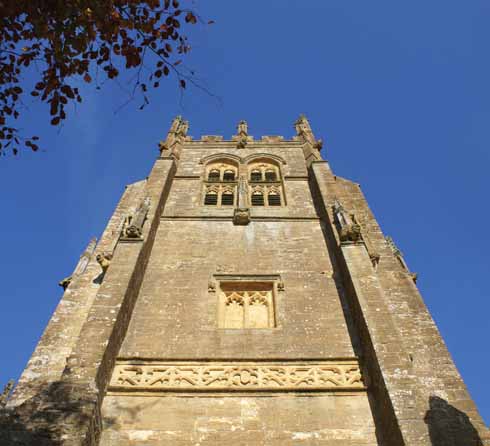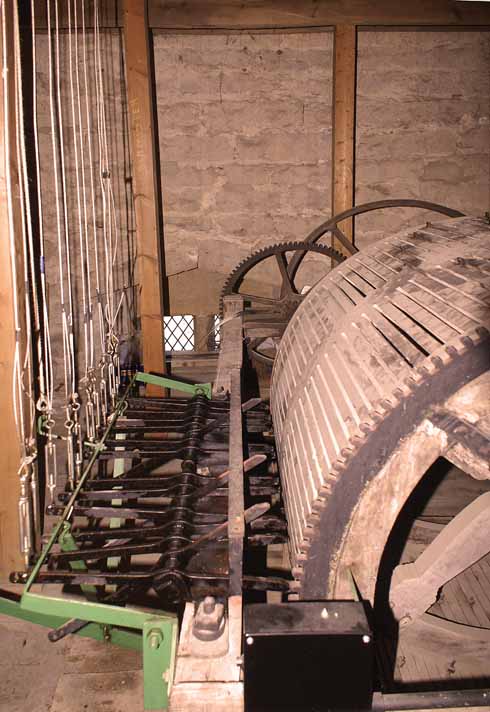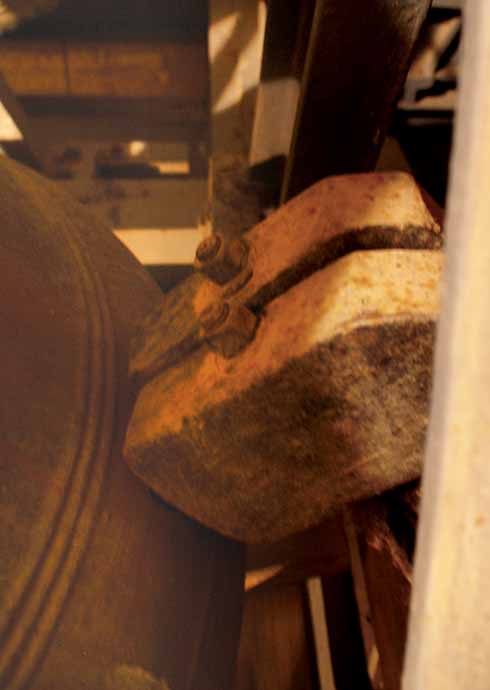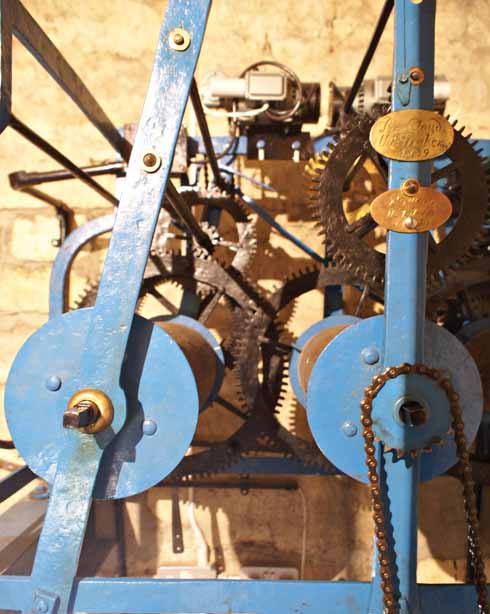The bells of St Mary’s
Joël Lacey looks at the strange tale of the missing chime of Beaminster's parish church
Published in January ’13
One of the glories of Beaminster is its church, St Mary of the Annunciation. As well as being an imposing piece of architecture that is easy on the eye, it is also rather easy on the ear, playing the hymn tune, Hanover, every three hours during the day between 9.00 in the morning and 9.00 in the evening, as well as sounding the quarter hours. There was a time, however, when there was a second chime tune.

The barrel of the chime mechanism. The dark blobs standing proud trip the levers on the right, which pull cables to hammers attached next to the bells. The indentations where the slits are wider are the location of the pegs which played the second, lost, chime.
The clock was electrified and the bells (now ten of them) re-hung in two lots – at right-angles to one another to prevent possible structural effects on the 16th-century tower – in the 1970s. The original chimes and clock, though, enjoyed anything but an untroubled existence. Correspondence from the parish archives reveals that sixty years before the chimes were re-hung and the clock electrified, there was an increasing problem with the system, and one that split opinions amongst the local church worthies as to how it might be resolved.
Then, as now, money was tight, and the letters between the craftsman engaged, the churchwarden, vicar and the gentleman who had offered to finance the latest set of repairs, is really quite revealing.
Even laying to one side the cost of any major repairs for a moment, the clock and chimes had not been an inexpensive business right from the outset. Parish records reveal that, even in 1844, Thomas Farnham, church clock maker, would undertake to ‘wind and time and keep in proper repair, the parish church clock and chimes for the sum of three pounds and ten shillings; for every service chimes for one pound ten shillings extra.’
A quarter of a century later, the Hanover tune chimes were added, and seventeen years later, in 1887, the bells were re-hung and George Power was charging the church one pound and ten shillings per quarter (six pounds a year) to ‘attend to the clock and chimes’.
But around January 1903, things started to go really quite wrong. O M Bennett was brought in to repair damage caused by the fall of a clock weight and to make a new frame for the clapper of the bell.
In 1905, W B Newman, about whom we shall read much more, made three visits – in May, July and September – to take out, readjust and re-fix the chime rope, to take out the old and put in a new chime rope and then, finally, to replace the chime wires and take up the slack in the chime rope. In all he charged a very reasonable eleven shillings and ninepence.
The parish accounts show entries for three more visits by Mr Newman in May, August and October 1910, and a five-day repair job in 1913. These two minimalist entries mask a rather greater story.

The cables enter the bell loft and spread out before rising to connect to the hammers which ring out the tune. The thicker ropes are those with which the bells are rung manually
M B Newman, in a letter entitled ‘Chiming apparatus at Mary’s Church’ to the Beaminster Churchwarden, Mr Kitson, wrote in July 1910: ‘Having examined the above apparatus I feel a difficulty in knowing what to advise; naturally after having been in use for 144 [sic] years, everything is much worn, especially the pins in barrel that lift the hammers, a great number of which require removing. Some of the hammers are very shaky and connecting wires, cranks etc require repair. The wood strips forming barrel are also worn away where pins fit between them which makes it difficult to keep pins in their proper positions. With all old apparatus of this description, it is very uncertain how long it will continue right after repair. I expect if you were to get a report from a firm of Carillon makers they would condemn the whole as worn out and useless, but I think if the above repairs were carried out, they would go on for some years.’
A A Leonard, Vicar of Beaminster between 1890 and 1912, wrote to Mr Kitson, on 28 July 1910, stating: ‘I send you a letter from Captain Codd. If you approve of accepting his offer to bear the cost of repairing, I think you and I should inform Newman formally and bind him down to time etc.’
Mr Kitson, wrote a letter – entitled ‘Chimes’ – to Captain Codd, to apprise him of the latest situation, on 9 August 1910: ‘My dear Codd, Leonard asked me on Sunday, if I could write to you and explain the above. The principal sense of the present irregularities of time appears to be that the inner pins, which are secured by nails between the wooden strips forming the face of the barrel, and strike the levers which operate the wires attached to the hammers, skip off them too quickly. On our visit to the chime loft last week, we came to the conclusion that the whole of the pins might [need to be] removed and Newman is to find out what he could. On Sunday evening he showed me a letter from Gillett and Johnson (a makers firm for clocks and bells) that they could not actually quote a price without knowing more, other than pins had been 1s6d apiece. Newman says there are 234 pins, and it is obvious that now they would cost much more and over what we contemplated paying for the whole job. He further tells us each one would take him at least two hours to make so it is pretty unlikely that he could make them for himself for much less, even supposing he can find time to make so many at all!
‘But of the 234, not quite half are used for old Hanover, the remainder being for the Sunday chiming for services. The latter are of much less importance than the former, and Newman is of [the] opinion that it would suffice to renew some fifty or sixty of the Hanover pins and readjust the new with the levers, wires, hammers etc. The work, he thinks, might easily be kept within £10 and finished within a reasonable period. He believes that £10 spent in this way would make the chimes keep much better time for many years to come, but he will not promise, alas, it would make a thoroughly good job; that, except taking out all the machinery and substituting a new barrel, etc of a modern description which, he expects, would cost £150. We would like, providing we have your approval, to adopt Newman’s proposal and authorise him to spend £10 on it.…

The bell loft at St Mary's church. The tower originally had five bells, which were recast – in the churchyard – into a ring of eight bells. Two more were added later to give the current complement of ten bells.
A month later, Kitson once again wrote to Captain Codd: ‘Dear Codd, I have been rather expecting a line from you about the chimes. Newman now tells me that he has heard again about the cost of the pins and it will not be as much as previously stated. They say they can now do them for 1s instead of 1s6d and that will of course make a great difference. Poor old Newman (William’s father) had a fit of epilepsy on Tuesday night just after going up to bed and was found on the floor by his bedside. They managed to get him into bed but he died half an hour after. This has given William a little more to do for a while, but I hope we shall get him to get to work with the chimes before very long if you say we should proceed.’
The perils, not so much of the postal system, but of the benefactor’s movement around the country are revealed by his next correspondence: ‘Dear Mr Kitson, Your letters of 9 & 26 August have just reached me at Princetown, where I am passing the “summer” on Dartmoor. Codd.’
Codd, writing again to Kitson, but this time from Bath in mid-October, informs the churchwarden: ‘I find, on my return here, a copy of the Beaminster Parish Magazine for September which contains a reference to my relations with the church chimes. In the interest of editorial accuracy, since an account is given in this trifling matter, I venture to point out … that I made no definite statement that the work was to be done at a cost not exceeding £10.’
Almost a year passes by and, in July 1911, Mr Kitson writes once again to the good Captain: ‘My Dear Codd, I am happy to say that I now fully understand your feelings with respect to the Beaminster chimes and that they are in perfect accord with my own: I believe it would be more or less a mistake to “tinker”.’
Two and a quarter years pass by before that previously mentioned brief entry in the Beaminster parish accounts of 16-20 October 1913: ‘Repairing winding apparatus of chimes and fitting new main spindle with turned bearings.’ This pause is not because of indecision, but rather other calls on the parish finances. Rather poignantly, according to parish records, in 1913 a new screen was erected in memory of Rev. A A Leonard M A, vicar 1890-1912.
And the second ‘Sunday call to service’ chime? Well, when the work was finally done in 1913, the hundred and twenty or so pins – which related to that second chime – do not appear to have been replaced. Certainly there is no such tune available now, and the round of bells call to service is now hand-pulled, as it were, on ropes by the church’s bell-ringers; they have to disconnect the clock-chiming mechanism first, though, as it would otherwise destroy the mechanism.
• Dorset Life would like to extend its thanks to Tower Captain Stevie Longridge of the Beaminster Bell Ringers, and to the Steeple Keeper, Chris Vye, for arranging access to the chime loft and to the bell loft for the purposes of illustrating this piece.






